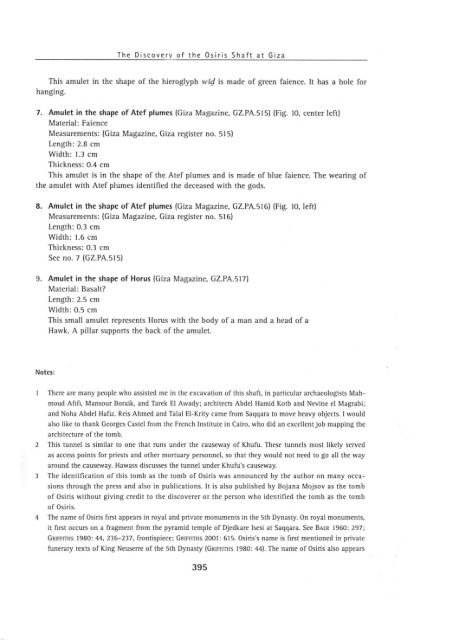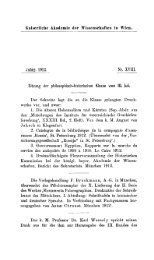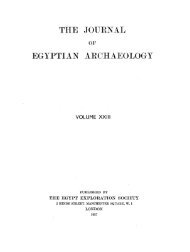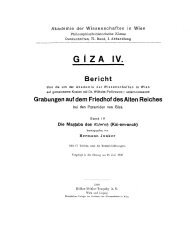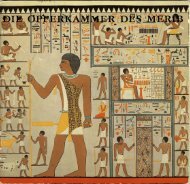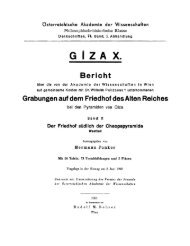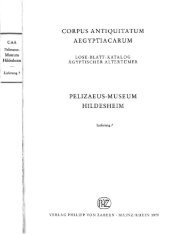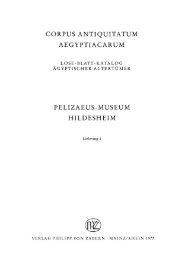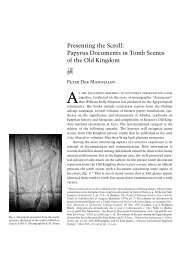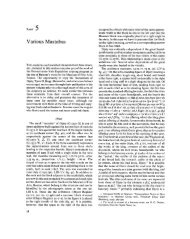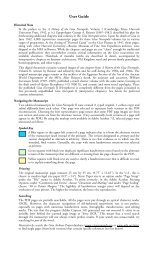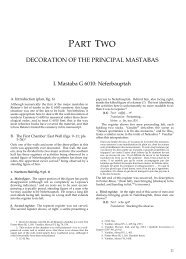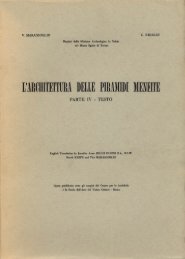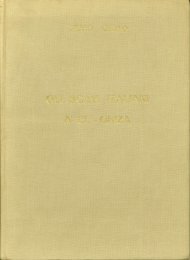The Discovery of the Osiris Shaft at Giza - Giza Archives Project
The Discovery of the Osiris Shaft at Giza - Giza Archives Project
The Discovery of the Osiris Shaft at Giza - Giza Archives Project
You also want an ePaper? Increase the reach of your titles
YUMPU automatically turns print PDFs into web optimized ePapers that Google loves.
<strong>The</strong> <strong>Discovery</strong> <strong>of</strong> <strong>the</strong> <strong>Osiris</strong> <strong>Shaft</strong> <strong>at</strong> <strong>Giza</strong><br />
This amulet in <strong>the</strong> shape <strong>of</strong> <strong>the</strong> hieroglyph wIg is made <strong>of</strong> green faience. It has a hole for<br />
hanging.<br />
7. Amulet in <strong>the</strong> shape <strong>of</strong> Atef plumes (<strong>Giza</strong> Magazine. GZ.PA.515) (Fig. 10, center left)<br />
M<strong>at</strong>erial: Faience<br />
Measurements: (<strong>Giza</strong> Magazine, <strong>Giza</strong> register no. 515)<br />
Length: 2.8 cm<br />
Width: 1.3 em<br />
Thickness: 0.4 em<br />
This amulet is in <strong>the</strong> shape <strong>of</strong> <strong>the</strong> Atef plumes and is made <strong>of</strong> blue faience. <strong>The</strong> wearing <strong>of</strong><br />
<strong>the</strong> amulet with Atef plumes identified <strong>the</strong> deceased with <strong>the</strong> gods.<br />
8. Amulet in <strong>the</strong> shape <strong>of</strong> Atef plumes (<strong>Giza</strong> Magazine. GZ.PA.516) (Fig. 10, left)<br />
Measurements: (<strong>Giza</strong> Magazine, <strong>Giza</strong> register no. 516)<br />
Length: 0.3 em<br />
Width: 1.6 em<br />
Thickness: 0.3 em<br />
See no. 7 (GZ.PA.515)<br />
9. Amulet in <strong>the</strong> shape <strong>of</strong> Horus (<strong>Giza</strong> Magazine, GZ.PA.517)<br />
M<strong>at</strong>erial: Basalt?<br />
Notes:<br />
Length: 2.5 em<br />
Width: 0.5 em<br />
This small amulet represents Horus with <strong>the</strong> body <strong>of</strong> a man and a head <strong>of</strong> a<br />
Hawk. A pillar supports <strong>the</strong> back <strong>of</strong> <strong>the</strong> amulet.<br />
<strong>The</strong>re are many people who assisted me in <strong>the</strong> excav<strong>at</strong>ion <strong>of</strong> this shaft, in particular archaeologists Mahmoud<br />
Aflfl, Mansour Boraik, and Tarek El Awady; architects Abdel Hamid Kotb and Nevine el Magrabi;<br />
and Noha Abdel HafIz. Reis Ahmed and Talal EI-Krity came from Saqqara to move heavy objects. I would<br />
also like to thank Georges Castel from <strong>the</strong> French Institute in Cairo, who did an excellent job mapping <strong>the</strong><br />
architecture <strong>of</strong> <strong>the</strong> tomb.<br />
2 This tunnel is similar to one th<strong>at</strong> runs under <strong>the</strong> causeway <strong>of</strong> Khufu. <strong>The</strong>se tunnels most likely served<br />
as access points for priests and o<strong>the</strong>r mortuary personnel, so th<strong>at</strong> <strong>the</strong>y would not need to go all <strong>the</strong> way<br />
around <strong>the</strong> causeway. Hawass discusses <strong>the</strong> tunnel under Khufu's causeway.<br />
3 <strong>The</strong> identific<strong>at</strong>ion <strong>of</strong> this tomb as <strong>the</strong> tomb <strong>of</strong> <strong>Osiris</strong> was announced by <strong>the</strong> author on many occa<br />
sions through <strong>the</strong> press and also in public<strong>at</strong>ions. It is also published by Bojana Mojsov as <strong>the</strong> tomb<br />
<strong>of</strong> <strong>Osiris</strong> without giving credit to <strong>the</strong> discoverer or <strong>the</strong> person who identified <strong>the</strong> tomb as <strong>the</strong> tomb<br />
<strong>of</strong> <strong>Osiris</strong>.<br />
4 <strong>The</strong> name <strong>of</strong> <strong>Osiris</strong> first appears in royal and priv<strong>at</strong>e monuments in <strong>the</strong> 5th Dynasty. On royal monuments,<br />
it first occurs on a fragment from <strong>the</strong> pyramid temple <strong>of</strong> Djedkare Isesi <strong>at</strong> Saqqara. See BAER 1960: 297;<br />
GRIFFffilS 19BO: 44, 236-237, frontispiece; GRrFFffilS 2001: 615. <strong>Osiris</strong>'s name is first mentioned in priv<strong>at</strong>e<br />
funerary texts <strong>of</strong> King Neuserre <strong>of</strong> <strong>the</strong> 5th Dynasty (GRIFFffilS 19BO: 44). <strong>The</strong> name <strong>of</strong> <strong>Osiris</strong> also appears<br />
395


